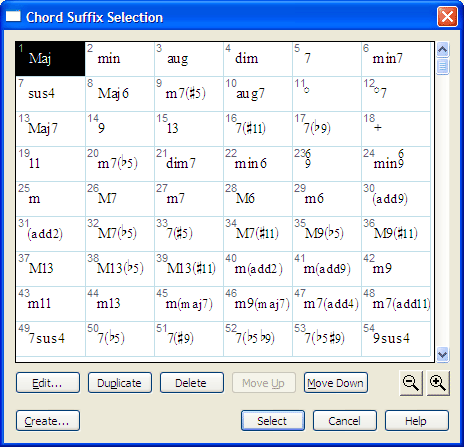|
L'aide française est disponible au format PDF en cliquant ici (ou dans le Menu "Démarrer", Finale 2010, Documentation PDF française)
Le tutoriel français est disponible au format PDF en cliquant ici.
La mise à jour de l'aide française au format HTML sera disponible prochainement.
|
Traduction française :

|
Chord Suffix Selection dialog box

How to get there
Click the Chord Tool  , choose Manual Input from the Chord menu, then click a note that doesn’t have a chord symbol attached. In the Chord Definition dialog box, click on Advanced to expand the dialog box. Click on Select near Suffix.
, choose Manual Input from the Chord menu, then click a note that doesn’t have a chord symbol attached. In the Chord Definition dialog box, click on Advanced to expand the dialog box. Click on Select near Suffix.
If a note has a chord symbol attached, click the note to make the chord handle appear. Double-click the handle, click on Advanced, and click Select.
What it does
The Chord Suffix Selection dialog box displays any chord suffixes you’ve created in (or loaded into) the document. It allows you to select, delete, or edit any of the suffixes; it also provides an entrance to the Chord Suffix Editor, where you can design new suffixes. The number in the top left corner of each item lists the slot number for the item. This can be handy if you have the option of typing in the slot number in a dialog box instead of scrolling through the selection dialog box. Occasionally, a character in parenthesis appears in the top right corner of an item in the selection dialog box. This character indicates the Metatool assigned to the item.
- Edit. If you’ve selected a suffix in the Chord Suffix Selection box by clicking it once, click Edit to enter the Chord Suffix Editor, where you can modify the suffix’s appearance or playback definition. Any alterations you make to one occurrence of a suffix automatically change all occurrences of that suffix throughout the score. You might use this technique, for example, to change all occurrences of "Gdim7" to "Go7".
- Create. If you don’t see the suffix you’re looking for in the Chord Suffix Selection box, click Create to enter the Chord Suffix Editor, where you can build one of your own.
- Duplicate. Click this button to create a copy of the selected Chord Suffix that you can modify with the Chord Suffix Editor. You can select more than one item. Use Shift-click to select an additional item and include all the items in between. Use ctrl-click to select only a specific additional item in the list.
- Delete. If you’ve selected a suffix in the Chord Suffix Selection box by clicking it once, click Delete to remove it from the selection box. You can select more than one item. Use Shift-click to select an additional item and include all the items in between. Use ctrl -click to select only a specific additional item in the list. If the suffix is used in the score, the Delete Element dialog box is displayed, where you can specify delete options. See Delete Element dialog box.
- Move Up • Move Down. Click these buttons to move the selected item or items up or down in the list. You can select more than one item. Use Shift-click to select an additional item and include all the items in between. Ctrl-click to select only a specific additional item in the list.
- [Magnifying glass icons]. Use the magnifying glass icons to zoom in and out. Click and drag the lower right corner of the dialog box and drag to resize it.
- Cancel. Click Cancel to return to the Chord Definition box without having made a suffix selection.
- Select. If you have clicked a chord symbol in the Chord Suffix Selection dialog box, click Select to return to the Chord Definition dialog box. Finale puts the number of the suffix you selected in the Chord Suffix ID text box and places the selected suffix in the score (when you click OK). Double-clicking a suffix is the same as clicking it once and clicking Select.
Tip: Choose duplicate to create a copy of a suffix. Then choose Edit to alter a suffix as you want it to be.
See Also:
Selection Overview
Chord Definition dialog box
Chord Tool



